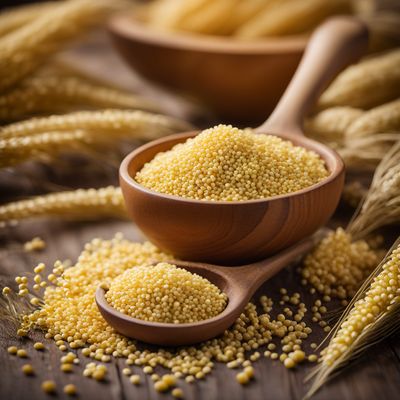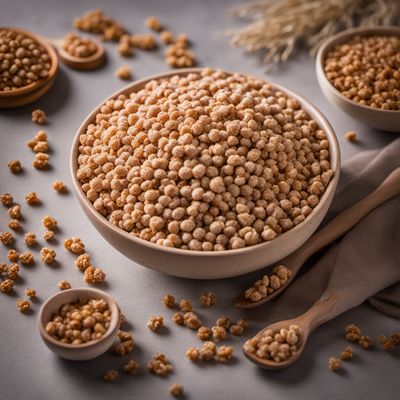
Ingredient
Cereal grains (and cereal-like grains)
The Versatile World of Grain: Exploring Cereal Grains and Their Kin
Cereal grains, such as wheat, rice, corn, oats, barley, and rye, are the edible seeds of grasses and are a staple food for many cultures. These grains are characterized by their hard outer husk, which protects the nutrient-rich endosperm, germ, and bran. Cereal-like grains, such as quinoa, amaranth, and buckwheat, are technically not true grains but are often used in similar ways due to their similar nutritional profiles and culinary versatility. Cereal grains and cereal-like grains vary in size, shape, color, and texture, with some being small and round (e.g., millet), while others are long and slender (e.g., rice). They can be processed into various forms, including whole grains, refined grains, flours, and flakes, each offering unique culinary applications and textures. These grains are known for their high carbohydrate content, providing a valuable source of energy, as well as essential nutrients like fiber, vitamins, minerals, and antioxidants.
Origins and history
Cereal grains have been cultivated for thousands of years, with their origins dating back to ancient civilizations in Mesopotamia, Egypt, and China. Wheat, one of the oldest cultivated grains, was a staple crop in ancient Egypt and played a significant role in the development of early civilizations. Rice, originating in Asia, has been cultivated for over 10,000 years and is a dietary staple for more than half of the world's population. Corn, native to the Americas, was domesticated by indigenous peoples and became a vital crop in the Americas and later spread to other parts of the world. The cultivation and consumption of cereal grains have shaped the course of human history, contributing to the development of agriculture, trade, and cultural exchange.
Nutritional information
Cereal grains are a rich source of carbohydrates, providing sustained energy. They also contain dietary fiber, which aids in digestion and promotes satiety. Additionally, cereal grains offer essential vitamins and minerals, such as B vitamins, iron, magnesium, and zinc. The nutritional content varies depending on the specific grain, but they generally contribute to a well-rounded and balanced diet.
Allergens
Wheat, barley, and rye contain gluten, making them unsuitable for individuals with gluten-related disorders or sensitivities. However, gluten-free alternatives like rice, corn, quinoa, and amaranth are available for those with dietary restrictions.
How to select
When selecting cereal grains, look for intact, unbroken grains that are free from moisture, insects, or signs of spoilage. Opt for whole grains whenever possible, as they retain the bran and germ, which contain valuable nutrients. Check the packaging for any indications of freshness or expiration dates. At farmers markets, choose grains that are locally sourced and have been recently harvested for optimal freshness.
Storage recommendations
To maintain the freshness and quality of cereal grains, store them in airtight containers in a cool, dry, and dark place. Whole grains can be stored for up to a year, while refined grains have a shorter shelf life. Avoid storing grains near strong-smelling foods, as they can absorb odors. Cooked grains should be refrigerated and consumed within a few days.
How to produce
Amateur gardeners can grow certain cereal-like grains like quinoa and amaranth in their home gardens. These grains thrive in well-drained soil and require full sun exposure. Sow the seeds directly into the soil after the last frost, keeping the soil consistently moist until the plants reach maturity. Harvest the grains when the seed heads have dried and turned a golden color.
Preparation tips
Cereal grains can be prepared in various ways, including boiling, steaming, baking, or grinding into flour. Before cooking, rinse whole grains to remove any debris or dust. To enhance the flavor, consider toasting the grains in a dry skillet before cooking. Experiment with different cooking techniques and seasonings to create diverse dishes, such as pilafs, risottos, salads, soups, bread, and porridges.
Substitutions
If you're looking for gluten-free alternatives to wheat, barley, or rye, consider using gluten-free grains like rice, corn, quinoa, amaranth, or buckwheat. These grains can be used in similar ways and offer unique flavors and textures.
Culinary uses
Cereal grains are incredibly versatile and are used in a wide range of culinary applications. They form the basis of staple dishes like bread, pasta, rice bowls, and breakfast cereals. Grains like quinoa and amaranth can be used as a nutritious substitute for rice or added to salads, soups, or baked goods. Corn is used in tortillas, polenta, and cornbread, while oats are commonly used in porridges, granolas, and baked goods. Barley is often used in hearty soups and stews, while buckwheat flour is used to make pancakes, noodles, and crepes.
Availability
Cereal grains and cereal-like grains are widely available in most regions and countries around the world. They are cultivated and consumed globally, making them accessible to a wide range of cuisines and culinary traditions.
More ingredients from this category

Rice and similar-
The Versatile Grain: Exploring the World of Rice

Rye and similar-
The Wholesome Grain: Exploring the Versatility of Rye and Similar Ingredients

Common millet and similar-
The Mighty Millet: A Versatile and Nutritious Grain

Maize and similar-
Golden Grains

Other cereals
Exploring the World of Lesser-Known Grains

Buckwheat and other pseudo-cereals and similar-
Nutritious Grains: Unveiling the World of Buckwheat and Pseudo-Cereals

Mixture of grains
The Wholesome Symphony: Exploring the World of Mixed Grains

Wheat and similar-
The Tangy Jewel of Nature

Barley and similar-
The Versatile Grain: Barley and its Varieties

Oat and similar-
The Versatile Grain: Oats and Their Kin

Sorghum and similar-
The Ancient Grain: Sorghum and Similar